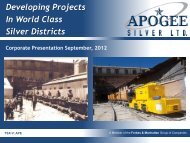Pulacayo Project Feasibility Study - Apogee Silver
Pulacayo Project Feasibility Study - Apogee Silver
Pulacayo Project Feasibility Study - Apogee Silver
You also want an ePaper? Increase the reach of your titles
YUMPU automatically turns print PDFs into web optimized ePapers that Google loves.
<strong>Pulacayo</strong> 1 000 t/d Phase I <strong>Feasibility</strong> <strong>Study</strong> - NI 43-101 Technical Report<br />
090644-3-0000-20-IFI-100<br />
7 GEOLOGICAL SETTING<br />
7.1 Regional Geology<br />
The regional geology of Bolivia is well described in various Bolivian government reports and<br />
is summarized in technical reports completed for <strong>Apogee</strong> by Micon in 2008, 2009, and 2010.<br />
The following regional geology description was extracted from the 2010 Micon report<br />
(Pressacco et al., 2010) that in turn is based on translated content from an <strong>Apogee</strong> company<br />
report (Iriondo et al. 2009) and US Geological Survey Bulletin (1975). The following text is<br />
presented without change from Cullen and Webster (2012).<br />
“In south western Bolivia, the Andes Mountains consist of three contiguous morphotectonic<br />
provinces, which are, from west to east, the Cordillera Occidental, the Altiplano, and the<br />
Cordillera Oriental. The basement beneath the area, which is as thick as 70 km, is believed<br />
to be similar to the rocks exposed immediately to the east, in the Cordillera Oriental, where a<br />
polygenic Phanerozoic fold and thrust belt consists largely of Paleozoic and Mesozoic<br />
marine shales and sandstones (Figure 7.1).<br />
Deposited mostly on Precambrian basement, the rocks of the Cordillera Oriental were<br />
deformed during at least three tectonic-orogenic cycles, the Caledonian (Ordovician), the<br />
Hercynian (Devonian to Triassic), and the Andean (Cretaceous to Cenozoic). The Altiplano<br />
is a series of high, intermontane basins that formed primarily during the Andean cycle,<br />
apparently in response to folding and thrusting. Its formation involved the eastward<br />
underthrusting of the Proterozoic and Paleozoic basement of the Cordillera Occidental,<br />
concurrent with the westward overthrusting of the Paleozoic miogeosynclinal rocks of the<br />
Cordillera Oriental. These thrusts resulted in continental foreland basins that received as<br />
much as 15,000 m of sediment and interlayered volcanic rocks during the Cenozoic.<br />
Igneous activity accompanying early Andean deformation was primarily focused further west,<br />
in Chile. During the main (Incaico) pulse of Andean deformation, beginning in the Oligocene<br />
and continuing at least until the middle Miocene, a number of volcano plutonic complexes<br />
were emplaced at several localities on the Altiplano, particularly along its eastern margin<br />
with the Cordillera Oriental, and to the south.<br />
In Pleistocene time, most of the Altiplano was covered by large glacial lakes. The great<br />
salars of Uyuni and Coipasa are Holocene remnants of these lakes. The Cordillera<br />
Occidental consists of late Miocene to Recent volcanic rocks, both lava flows and ash flow<br />
tuffs, primarily of andesitic to dacitic composition, that have been erupted in response to the<br />
subduction of the Nazca plate beneath the continent of South America. This underthrusting<br />
continues, and many of the volcanoes that form the crest of the Andes and mark the<br />
international border with Chile are presently active”.<br />
TWP Sudamérica S.A. Av. Encalada 1257 Of. 801, Santiago de Surco Lima 33, Perú (51-1) 4377473<br />
Page 34



